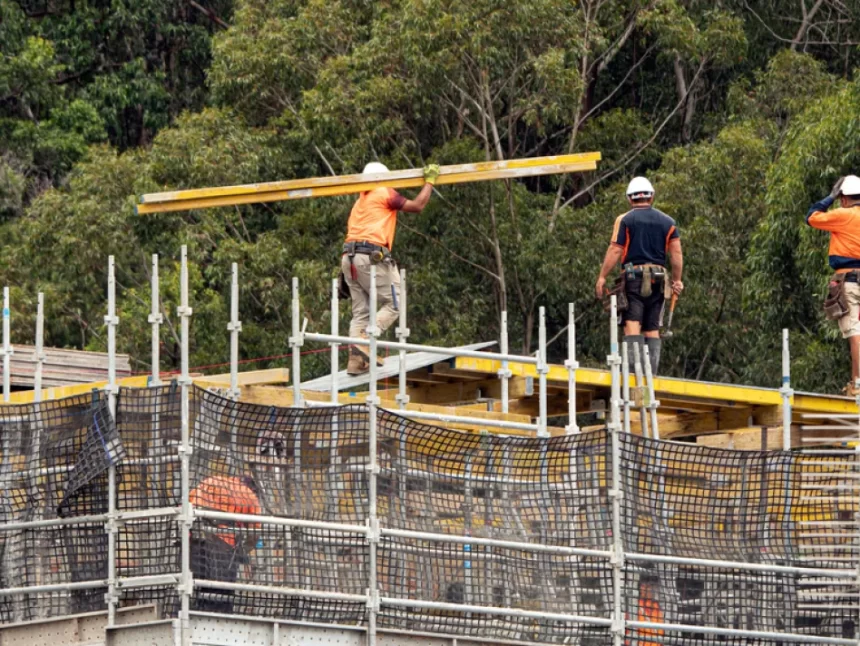A new report has revealed a massive shortfall in skilled workers is putting the future of Australia’s infrastructure, housing and energy “under threat”.
Australia’s infrastructure advisory agency, aptly called Infrastructure Australia, predicts the nation’s shortfall of 229,000 skilled workers will jeopardise billions of dollars worth of planned construction projects.
The agency is also sounding the alarm over shortages of construction materials, with parts of the country struggling to access enough steel, rock and sand supplies for major projects.
Chief Executive Adam Copp said the construction activity and demand for building materials, skills, and labour is at a “historic high”.
“The infrastructure sector is delivering a major public infrastructure pipeline valued at $230 billion over five years,” he said in a statement.
“This is occurring alongside a plan to build 1.2 million new homes as well as major investment in the energy sector, which is quadrupling over that same period.
“With so much construction activity underway, the industry is finding it increasingly difficult to source key building materials and workers – particularly engineers, skilled trades and labourers.”
Trades and labourer shortages are growing at the fastest rate in the country (peaking at 131,000 workers in 2024) and are set to remain high until 2025.
According to the report, Australia’s infrastructure workforce must grow by 127 per cent to meet the rising demand.
Mr Copp also raised concerns over Australia’s growing dependence on imported materials, claiming that domestic shortages had increased overseas orders by 20 per cent in the last two years.
“Australia’s lack of domestic capacity to supply building materials exposes investments to cost-overruns, delays and future global supply chain risks. It’s also much more difficult to understand the level of embodied carbon in imported materials,” he said.
“Currently, there is no method for collecting or analysing data on local manufacturing and production outputs at the national level, hindering the ability to predict supply and mitigate for shortfalls, as we can do with labour.
“A clear message in this year’s report is that limited access to local steel and cement, as well as localised shortages of quarry products is contributing to price uncertainty in the supply chain, leading to delays and cost overruns.”
This is the third time the advisory agency has highlighted labour and material shortages in the sector in as many years.
Australian Constructors Association (ACA) CEO Jon Davies hopes the report is a “wake-up call” that sparks immediate industry-wide changes to meet Australia’s infrastructure needs.
“The lack of substantial progress since the report’s inaugural release two years ago reinforces the need for bold, transformative action,” said Mr Davies.
“Current incremental changes are falling short; migration is on the rise, yet the workforce shortfall persists, with shortages already at 229,000 full-time workers.
“The reality is Australia’s construction industry needs to learn to do more with the resources it has, but to do this, the sector’s ‘operating system’ requires a complete overhaul—and someone needs to take the lead.”
Building a better industry
Mr Copp concluded the report by urging the federal government partner with state and industry bodies to secure the long-term sustainability of the sector.
“Australia has an opportunity to build domestic capacity and markets for new low emissions construction materials, such as recycled materials,” said Mr Copp.
“For major road projects, our modelling suggests that close to a third of conventional materials – 54 million tonnes annually – could be replaced with recycled materials.”
According to Mr Davies, one crucial element was missing from the report’s recommendations — a “transformative, all-encompassing” National Construction Strategy to implement these recommendations now.
“ACA proposes a collaborative initiative led by the Federal Government, engaging state and territory governments, industry stakeholders and unions to develop a National Construction Strategy,” he said.
“Key components of the proposed National Construction Strategy include the development of nationally consistent procurement principles and a unified approach to construction data collection.
“The National Construction Strategy would also articulate a strategic framework for elevating the overall skill level of the construction industry. This includes reskilling initiatives to adapt to emerging technologies.
“With a National Construction Strategy Australia can finally create a sustainable industry that is forward-looking, embracing new ways of doing things, while being a diverse industry of choice for the next generation of the workforce.”







